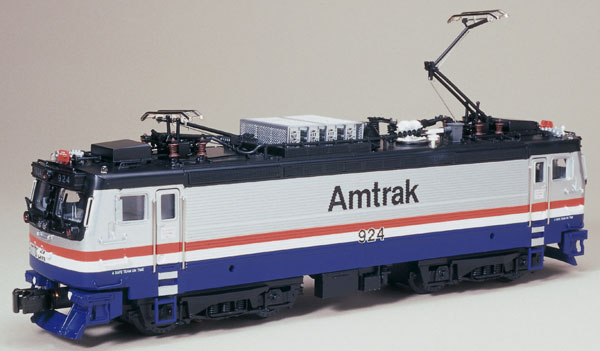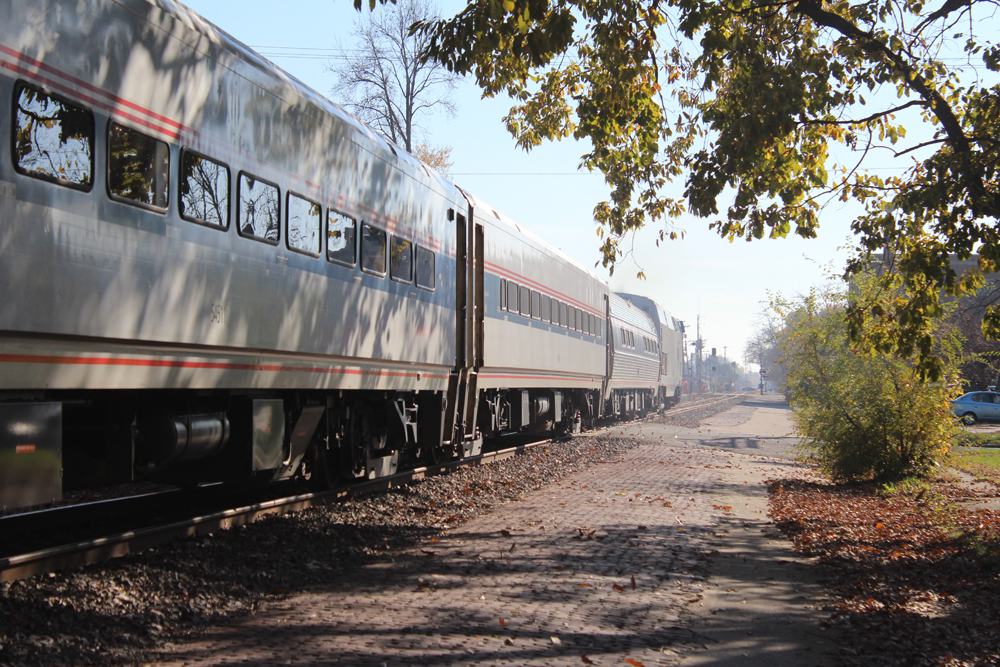This engine differs from the others, however. Although the prototype numbers for the AEM7 are small, the engine is an unqualified success!
The engine won a design contest held by Amtrak for a 7,000-horsepower replacement for its prewar vintage GG1 electrics.
From 1979 to 1988, EMD built 66 AEM7s under license (from the Swedish firm ASEA). When NJ Transit went shopping for an electric locomotive for commuter operations in 1990, it purchased 15 directly from ASEA. These units were the same basic locomotive as the AEM7, but were designated ALP44s by the manufacturer.
The AEM7 has racked up more than 20 years of reliable service for Amtrak and several commuter agencies, and has finally been commemorated in O gauge by both Atlas O and MTH.
We examined the no. 20-5505-1 Premier line model in Amtrak colors. It is a very attractive model. Its coupler-to-coupler length is just over 13 inches (52 scale feet) and the shell is 12 inches (a match for the prototype’s 50-foot length). With pantographs lowered, it measures 4 inches (16 scale feet) tall.
There is an amazing amount of detail crammed into this model. The body has a nice textured, ribbed feel. Each cab door has added-on metal handrails. There are at least 28 other grab irons dotting the body. Many of these are plastic, however, and we managed to crack a few in normal handling.
Topside detail includes a large number of electrical “doo-dads” to provide power to the motor from the pantographs. In the center of the roof, there is a neat metal grill with a maze of electrical components in a three-dimensional style. This is a notable difference from Atlas O’s AEM7 locomotive, which uses this rooftop compartment to conceal Locomatic controls.
The locomotive has clearly defined windshield wipers, rear-view mirrors, and safety warning signs. The engine has cabs on both ends, and features an engineer figure.
The AEM7 also has marker lights, headlights, strobes, and illuminated number boards on both ends. The headlight is directional as are the strobe lights. The unit also features die-cast metal trucks and couplers.
Decoration is top notch. Paint was applied smoothly, and we noted no blemishes or imperfections. The blue in the bottom stripe struck the CTT staff as being a bit dark for Amtrak, but the overall paint job is very pleasing. The darker blue looks correct for Amtrak’s Northeast Corridor trains. The blue does match the Amfleet passenger cars that MTH released in late 1999. The engine is also available decorated for the South East Pennsylvania Transportation Authority (SEPTA) commuter system.
Operation
Since comparisons are inevitable, the main differences between the MTH AEM7 and the Atlas O AEM7 are internal. The Atlas O engine uses a single can motor mounted in the center of its frame that powers each truck with a drive shaft. The MTH model uses two can motors, one over each truck. Additionally, the Atlas O version offers the Locomatic control system and a Dallee sound system, while the Premier line AEM7 offers the ProtoSound control and sound system.
Performance of the Premier line AEM7 is commendable. Drawbar pull for the 5-pound, 5-ounce engine was 2 pounds, which is roughly equal to more than 120 modern, free-rolling pieces of rolling stock on straight and level track. The engine even looked and sounded good on the front of a freight train.
Our test engine operated smoothly in all speed ranges and averaged 13.8 scale mph on the low end and 151.5 scale mph at 18 volts.
The sound system was very good, but as with the Atlas O version, the MTH AEM7 sounds like a large industrial air-conditioning unit or a large motor generator. Don’t expect something rivaling diesel engine sounds.
The horn was clear and distinct and the bell could probably wake the dead in your trackside cemetery. We did notice that at about 12 volts, the noise of the motor began to overtake the sound system.
This was easy to remedy by adjusting the volume by accessing a ProtoSound reset level or simply using the manual control on the belly of the engine.
Comparing two AEM7s
The level of detail on both the Atlas O and MTH locomotives is comparable. The equipment detail on the roof of the MTH engine might look a bit more precise, while the blue shade of the Atlas O engine might be more like your local Amtrak train.
The ProtoSound system has an edge over the Atlas O sound system, though in either case the sound of the AEM7 itself is a bit elusive. The ProtoSound system does, however, have the extra feature of cab chatter.
Performance is comparable. The MTH engine averaged 2 pounds of drawbar pull, a low speed average of 13.8 scale mph, and a high of 151.5 scale mph. The Atlas O locomotive averaged 2.2 pounds of drawbar pull, a low speed of 41.6 scale mph, and a high speed of 125 scale mph.
The main factor influencing your choice may be whether or not you prefer a single motor powering two trucks or two motors powering two trucks.
The Premier line AEM7 is another excellent MTH locomotive. While it looks good leading a passenger train, only the road name would be out of place on the front of a long, heavy freight train!














